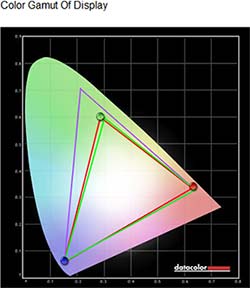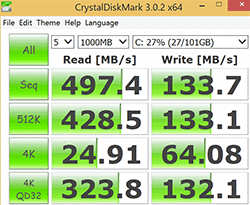Keyboard and Trackpad
The signature smile shaped keys and good tactile feel make this every bit a Lenovo keyboard, though travel is shorter compared to bigger IdeaPad and ThinkPad models. The key tops are a bit slick and glossy, but we love the damped feel and quiet sound from the keys. The good news is that Lenovo added white backlighting, so typing in dim places isn't a terror. You can turn backlighting and off using the Fn and spacebar keys, so you're not at the mercy of a flakey ambient light sensor. To use multimedia keys on the top row, simply press them: there's no need to hit the Fn key first. The large trackpad is responsive and well behaved, as we've come to expect from Lenovo.
QHD+ Display
When the Yoga 2 Pro started shipping a few weeks ago, early adopters with keen eyes noted that yellows looked more like dull mustard. Lenovo has already released a BIOS update and Energy Manager update that remedies this, and we expect future shipments will have the new firmware and software pre-installed. After the fix, yellows look more normal, though a trained graphics pro might find them slightly off. Other colors continue to render properly with the update, so you've got a display with rich colors that's perfect for watching movies, viewing photos and editing them too.
This is a superb 13.3" QHD+ display that's made by Samsung and is in fact the same panel used in Samsung's flagship Ultrabook, the Samsung ATIV Book 9 Plus. Some folks call the PLS display PenTile, but that's really a term used for Samsung Super AMOLED displays used in smartphones. This is not Super AMOLED, it's PLS which is akin to IPS and it has IPS' level of viewing angles and clean whites. The display has the same very wide color gamut that achieves 97% of sRGB and 75% of Adobe RGB as measured by our Datacolor Spyder 4 Pro monitor calibrator (after the display firmware update). That places the Yoga 2 pro in the rarified company of the ATIV Book 9 Plus, Sony Vaio Pro 13, Sony Vaio Flip 13 and Vaio Duo 13 for the best color gamut on a touchscreen Ultrabook. Brightness is also excellent at 350 nits, though you'll have to disable Windows' auto-brightness to get full brightness. Contrast is very good and it puts the IdeaPad U430 Touch and other TN panels to shame.
The display resolution sounds insanely high and it is. Thankfully, the laptop ships with Windows 8.1, which handles display scaling better. It defaults to 200% zoom that makes for razor sharp text and icons that are a manageable size. Not all applications respect Windows scaling, for example Adobe Photoshop has quite small menu text at full resolution. MS Office and Metro apps respect scaling and look great. Chrome is hit or miss, and if you find text is too tiny, enter chrome://flags in the URL bar and enable high DPI features for a much better experience. When we first received the Samsung ATIV Book 9 Plus a few months ago, I wondered if the crazy high resolution wasn't more than a marketing trick. Particularly with Windows 8.1, I can tell you it's not: everything looks sharper and 13.3" full HD displays' text now looks a little fuzzy to me after using QHD+ for a few months.
The display supports 10 points of multi-touch but it is not an active digitizer. No Wacom, no N-Trig... no active digital pen of any kind. If you're an artist or avid note taker, this isn't your machine. You can use a capacitive stylus but those are thick, imprecise and don't offer palm rejection. If you do need a digital pen, consider the Microsoft Surface Pro 2, the aging Asus Taichi, Sony Vaio Flip or Sony Vaio Duo 13. Lenovo will have a Wacom pen option for the ThinkPad Yoga, but we don't yet know when that will be available.

Quiet and Smooth Operator
The Lenovo is quiet and cool for productivity work and even streaming an hour of HD video didn't get it hot and bothered. The machine has two fans, but we rarely heard them when working in MS Word or browsing the web. They kick in from time to time when working with big Photoshop RAW files or editing video, but they're neither loud nor annoyingly high pitched (ahem, noisy Sony Vaio Flip 13). The laptop never exceeded human body temperature, and was comfortable for lap use. If you play Civ V or Warcraft the fans will ramp up, but the same is true of all thin and light laptops.
Performance and Horsepower
The Lenovo Yoga 2 Pro ships with 4th generation Intel Haswell CPUs. These are ULV U series CPUs commonly used on Ultrabooks and not the slightly slower and lower power Y series CPUs used in the Yoga 11s and Sony Vaio Tap 11. You can order the Yoga 2 Pro with your choice of Core i3, i5 and i7 CPUs, and we generally recommend the Core i5. Why? The Core i3 lacks Turbo Boost and the i7 doesn't add much in terms of performance. Our unit has the usual 1.6GHz Intel Core i5-4200U with 4 gigs of DDR3L RAM and a 128 SSD drive. You can order it with 8 gigs of RAM or a larger SSD if you wish. RAM is soldered on board so you can't upgrade it later. The SSD is fairly easy to upgrade and it's the common mSATA drive used in many Ultrabooks. For the price, you won't get the newer and faster PCIe SSD interface; the Yoga 2 Pro is strictly mSATA.
Performance falls just where we'd expect from a Haswell Core i5 and the machine's dual channel RAM gives a little graphics boost since integrated graphics uses system RAM for graphics memory. As with most Ultrabooks, there's no dedicated graphics option, but the Intel HD 4400 is good enough for smooth Photoshop work, light CAD work and 3D gaming at modest settings for games like Civ V and WoW. Casual and Metro games are no problem at high settings, but forget Battlefield 4 on mid or high settings: Ultrabooks aren't gaming rigs.
Benchmarks
(1.6 GHz Intel Core i5-4200U, 8 gigs RAM and 128 gig SSD)
PCMark 7: 4737
3DMark 11: P887
wPrime: 22.96 sec.
PCMark 7 Benchmark Comparison Table
CrystalDiskMark SSD Scores

Wireless
The Yoga 2 Pro is an IdeaPad, and thus it suffers the IdeaPad curse: single band 2.4GHz WiFi. It's a decent Intel N-7260 802.11n adapter with Bluetooth 4.0, but we continue to lament the lack of 5GHz band on Lenovo's IdeaPad products. For $1,000 and up, we should get dual band WiFi 802.11n like other Ultrabooks in this price range. Why am I making such a big deal of this? Because Bluetooth also uses the 2.4GHz band, and sometimes Bluetooth peripherals like mice and speakers can cause network glitches or drops. Some colleges now require laptops with dual band WiFi in their recommended specs for students. 802.11n with dual band is faster than single band WiFi. Now that we've complained, 2.4GHz travels a longer distance than 5GHz and that means you'll likely get farther from your router before things get dicey. Overall we had good reception, though our Bluetooth speakers did indeed cause occasional pauses in streaming HD video playback.
Battery Life
The convertible has a 4 cell, 54 Whr Lithium Ion polymer battery that's sealed inside. If you remove the bottom cover, you'll discover it's not that hard to replace should it die of old age in a few years, but it's not designed to pop in and out easily. Lenovo rates the battery at 9 hours for productivity with WiFi off and 6 hours for video playback with the display set to 150 nits of brightness (350 is max brightness). In our tests with WiFi on and brightness set to 50%, the machine lasted 6.3 hours in a mix of MS Office, email, social networking, web browsing using IE and streaming an hour episode via Netflix. We went with the standard balanced power configuration and disabled auto-brightness. If you use a low power plan and reduce brightness, you could hit 7 hours of use. The Yoga 2 Pro has runtimes that are similar to the Haswell Acer Aspire S7, Sony Vaio Pro 13 and Vaio Flip 13, but falls short of the Samsung ATIV Book 9 Plus, Sony Vaio Duo 13 and the 13" MacBook Air.
The Lenovo ships with a slim charger and it uses their newer rectangular charging connector and port that are color coded yellow so you don't mistake it for USB. The laptop charges quickly and it's compatible with higher watt chargers such as the ThinkPad X1 Carbon charger.
Conclusion
Lenovo has another hit with the IdeaPad Yoga 2 Pro. I honestly hope they can make enough of them, because inventory constraints are likely the only thing that could hold sales back. At 3 pounds, this slim Ultrabook is easy to take anywhere, and it's one of the few designs that can be all things to all people: laptop, tablet, presentation machine and a few things in between. Only the Sony Vaio Flip 13 and Dell XPS 12 beat the Yoga design, but some will prefer the Yoga's sturdy hinges to the thin flipping lid on the Vaio. The Yoga 2 Pro offers undeniable value and you get a couple of very high end features like the QHD+ display and backlit keyboard for your money. In terms of looks and materials, you won't confuse this with the high end offerings from Apple, Samsung, Asus and Acer, but it is well put together and durable. Our only real complaints are the single USB 3.0 port and single band WiFi, which show a little corner cutting to keep the price down.
Website: www.lenovo.com
Price: $999 for the Core i5, 4 gigs RAM and 128 gig SSD, higher configurations available at higher prices.
Related Reviews:
Lenovo Yoga 3 Pro Review
Lenovo ThinkPad Yoga Review
Lenovo Yoga 2 13 Review
Lenovo ThinkPad X1 Carbon (2014) Review
Lenovo ThinkPad Helix Review
Sony Vaio Flip 13 Review
Lenovo Flex 14 Review
Samsung ATIV Book 9 Plus Review
Asus Zenbook UX301 Review
Acer Aspire R7 Review
Microsoft Surface Pro 2 Review
Sony Vaio Pro 13 Review
Sony Vaio Duo 13 Review
Dell XPS 12 Review |

